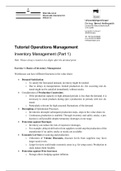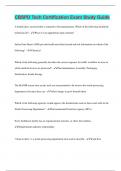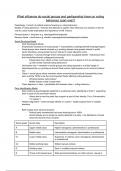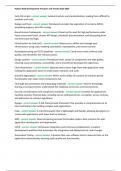Universitätsprofessor
Dr.-Ing. Bernd Hellingrath
Lehrstuhl für Wirtschaftsinformatik
und Logistik
Leonardo-Campus 3
48149 Münster
Tel. +49 251 83-38000
Fax +49 251 83-38009
Tutorial Operations Management
Inventory Management (Part 1)
Hint: Please always round to two digits after the decimal point.
Exercise 1: Basics of Inventory Management
Warehouses can have different functions in the value chain:
• Demand Satisfaction
o To satisfy the forecasted demand, inventory might be needed.
o Due to delays in transportation, limited production etc. the occurring real de-
mand might not be satisfied immediately without stocks.
• Consideration of Production Constraints
o If the production capacity in high-demand periods is less than the demand, it is
necessary to stock products during (pre-) production in periods with low de-
mand.
o Particularly relevant for high seasonal fluctuations of the demand.
• Decoupling of Operational Processes
o Inventories decouple subsequent production steps, steps in the value chain etc.
o Continuous production is enabled. Through inventory and safety stocks, a pro-
duction is still possible despite temporary shortages at one stage.
• Protection against Shortages
o Inventory can reduce the risk of expensive shortages.
o For example, delayed deliveries from suppliers would stop the production of the
manufacture if no safety stocks or stocks are available.
• Economic Lot Sizes in sourcing and production
o Utilization of Volume Discounts, discount levels from suppliers may favor
larger stock levels.
o Larger lot sizes could make economic sense (e.g. for setup costs). Production to
stock makes them feasible.
• Protection against Price Increases
o Storage allows hedging against inflation.
, 2
Exercise 2: Economic Order Quantity– Basic Model
a)
The economic order quantity model takes into account fixed as well as variable ordering costs
and carrying costs. The demand is assumed to be deterministic and is regarded over several
periods.
b)
Assumptions of the Economic Order Quantity Model:
The demand is deterministic and constant with a rate of µ. Orders are unlimited and delivered
immediately. The target value is the optimal order quantity x* for one single product.
Fundamental Relations of the Economic Order Quantity Model:
Based on the demand rate, which is assumed to be known, the optimal order quantity x* can be
µ x
calculated. The total costs Z(x) = cµ + K + h are minimal for this order quantity. The
x 2
x*
optimal order quantity results in the optimal cycle length T = and the number of orders
µ
1 µ
per year N= = * .
T x
Dr.-Ing. Bernd Hellingrath
Lehrstuhl für Wirtschaftsinformatik
und Logistik
Leonardo-Campus 3
48149 Münster
Tel. +49 251 83-38000
Fax +49 251 83-38009
Tutorial Operations Management
Inventory Management (Part 1)
Hint: Please always round to two digits after the decimal point.
Exercise 1: Basics of Inventory Management
Warehouses can have different functions in the value chain:
• Demand Satisfaction
o To satisfy the forecasted demand, inventory might be needed.
o Due to delays in transportation, limited production etc. the occurring real de-
mand might not be satisfied immediately without stocks.
• Consideration of Production Constraints
o If the production capacity in high-demand periods is less than the demand, it is
necessary to stock products during (pre-) production in periods with low de-
mand.
o Particularly relevant for high seasonal fluctuations of the demand.
• Decoupling of Operational Processes
o Inventories decouple subsequent production steps, steps in the value chain etc.
o Continuous production is enabled. Through inventory and safety stocks, a pro-
duction is still possible despite temporary shortages at one stage.
• Protection against Shortages
o Inventory can reduce the risk of expensive shortages.
o For example, delayed deliveries from suppliers would stop the production of the
manufacture if no safety stocks or stocks are available.
• Economic Lot Sizes in sourcing and production
o Utilization of Volume Discounts, discount levels from suppliers may favor
larger stock levels.
o Larger lot sizes could make economic sense (e.g. for setup costs). Production to
stock makes them feasible.
• Protection against Price Increases
o Storage allows hedging against inflation.
, 2
Exercise 2: Economic Order Quantity– Basic Model
a)
The economic order quantity model takes into account fixed as well as variable ordering costs
and carrying costs. The demand is assumed to be deterministic and is regarded over several
periods.
b)
Assumptions of the Economic Order Quantity Model:
The demand is deterministic and constant with a rate of µ. Orders are unlimited and delivered
immediately. The target value is the optimal order quantity x* for one single product.
Fundamental Relations of the Economic Order Quantity Model:
Based on the demand rate, which is assumed to be known, the optimal order quantity x* can be
µ x
calculated. The total costs Z(x) = cµ + K + h are minimal for this order quantity. The
x 2
x*
optimal order quantity results in the optimal cycle length T = and the number of orders
µ
1 µ
per year N= = * .
T x












